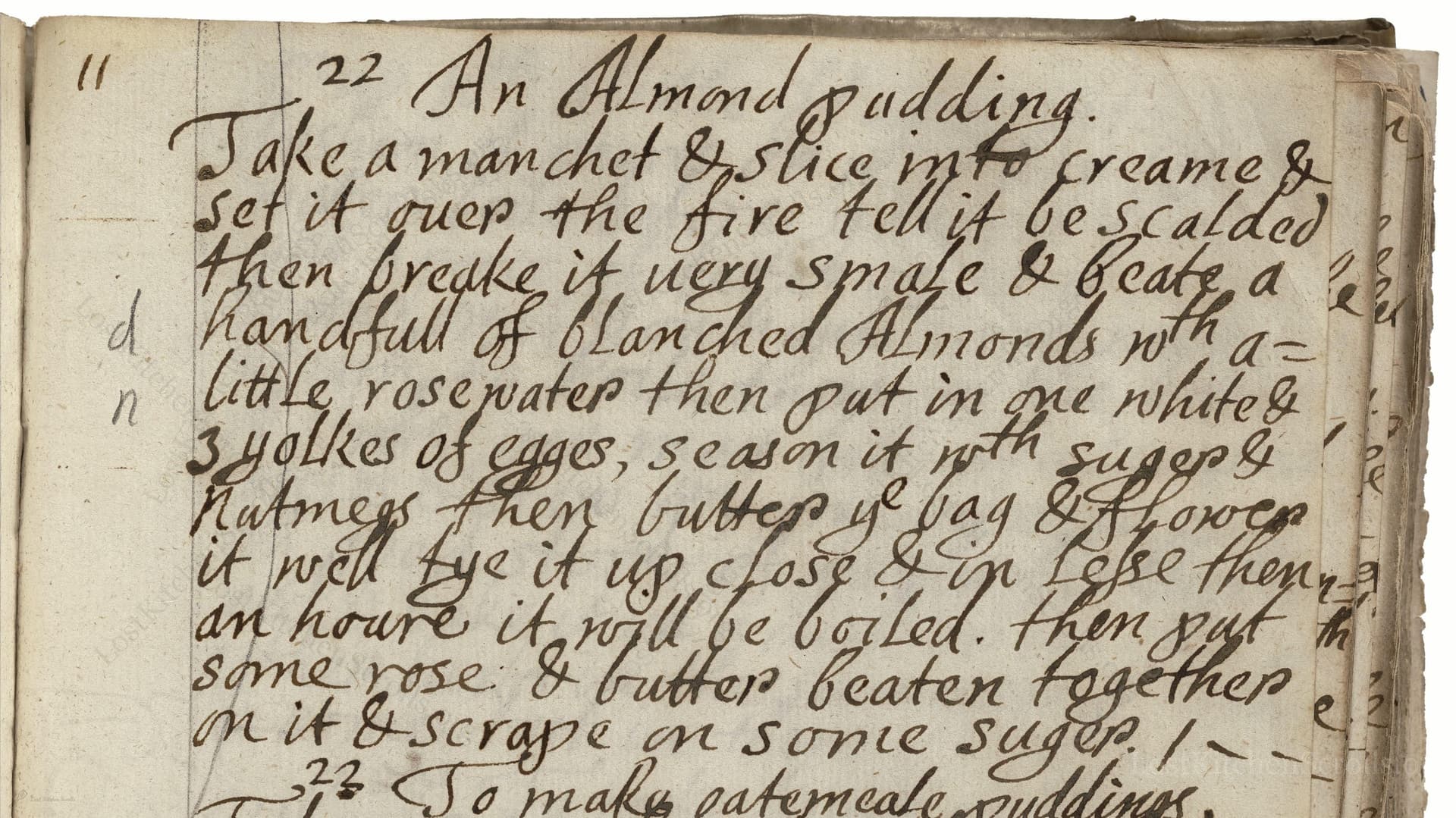An Almond Pudding
From the treasured pages of Cookbook of L. Cromwell
Written by L. Cromwell

An Almond Pudding
"Take a manchet & slice into creame & set it ouer the fire tell it be scalded then breake it very smale & beate a handfull of blanched Almonds with a little rosewater then put in one white & 3 yolkes of egges, season it with suger & Nutmegs then butterr ye bag & flower it well tye it up close & in lesse then an houre it will be boiled. then put in some rose. & butterr beaten together on it & scrape on some suger. /-"
Note on the Original Text
Historical recipes like this were written with little punctuation and using period-specific spelling: 'manchet' for bread, 'ouer' for over, 'beate' for beat, etc. There are few precise instructions—quantities and timings are relaxed, as much was assumed knowledge in the kitchen. Directions emphasize process (beating, tying, boiling) rather than temperature or exact timings. Spelling was not standardized, so expect creative variations such as 'egges' and 'suger'.

Title
Cookbook of L. Cromwell (1650)
You can also click the book image above to peruse the original tome
Writer
L. Cromwell
Era
1650
Publisher
Unknown
Background
Step back into the sumptuous kitchens of the 17th century, where L. Cromwell’s collection stirs up a medley of grand flavors and old English culinary traditions—a true feast for culinary historians and curious cooks alike.
Kindly made available by
Folger Shakespeare Library
This recipe originates from the early 1600s, during the time of the English Civil War and the Cromwellian era. Lady Cromwell’s household likely enjoyed such delicate puddings, which were considered both nourishing and refined. Almonds, rosewater, and costly spices like nutmeg were the hallmarks of luxury for those who could afford them. Puddings were a sign of culinary sophistication and experiments with dairy, bread, and imported flavors mark the move towards the rich, custardy puddings we know today.

The original recipe would have required a mortar and pestle for grinding the almonds, a pan for heating the cream and bread, and a strong spoon or 'beater' for mashing. The pudding would be boiled in a linen pudding cloth tied securely with string—cooked in a cauldron or large pot over an open hearth. Measuring was often by eye or custom, not by scale.
Prep Time
20 mins
Cook Time
50 mins
Servings
4
We've done our best to adapt this historical recipe for modern kitchens, but some details may still need refinement. We warmly welcome feedback from fellow cooks and culinary historians — your insights support the entire community!
Ingredients
- 3.5 oz white bread roll (manchet, or substitute with challah/brioche)
- 1 cup heavy cream
- 1.75 oz blanched almonds
- 1 tbsp rosewater
- 1 egg white
- 3 egg yolks
- 2 tbsp sugar
- 1/2 tsp fresh grated nutmeg
- 2 tbsp butter (for sauce and greasing)
- 1 tbsp flour (for dusting the cloth)
- Extra sugar for finishing
Instructions
- Start by slicing about 3.5 ounces of a good-quality white bread roll (a manchet was a fine white bread of the period) and soak it in 1 cup of heavy cream.
- Gently warm the mixture over low heat until the bread is soft and has absorbed the cream, but do not let it boil.
- Remove from the heat and mash or beat the mixture with a spoon until smooth.
- In a separate bowl, finely grind 1.75 ounces of blanched almonds with 1 tablespoon of rosewater until it forms a paste.
- Add this to the bread and cream mixture.
- Mix in 1 egg white and 3 egg yolks, stirring well.
- Season with 2 tablespoons of sugar and a generous grating of nutmeg.
- Butter a pudding cloth (or clean kitchen towel or muslin) well, dust with flour, and spoon the mixture into the center.
- Tie it up tightly into a secure bundle.
- Bring a large pot of water to a boil and immerse your pudding bundle.
- Simmer gently for about 45-50 minutes.
- Once cooked, carefully remove the pudding, untie, and turn out onto a serving dish.
- Melt some butter (about 2 tablespoons) with a splash of rosewater, pour over the pudding, and finish with an extra sprinkle of sugar on top before serving.
Estimated Calories
390 per serving
Cooking Estimates
You'll need about 20 minutes to prepare the ingredients and mix everything together before it goes into the pot. Cooking the pudding takes another 50 minutes. Each serving contains around 390 calories, and this recipe will serve 4 people.
As noted above, we have made our best effort to translate and adapt this historical recipe for modern kitchens, taking into account ingredients nowadays, cooking techniques, measurements, and so on. However, historical recipes often contain assumptions that require interpretation.
We'd love for anyone to help improve these adaptations. Community contributions are highly welcome. If you have suggestions, corrections, or cooking tips based on your experience with this recipe, please share them below.
Join the Discussion
Rate This Recipe

Den Bockfisch In Einer Fleisch Suppen Zu Kochen
This recipe hails from a German manuscript cookbook compiled in 1696, a time whe...

Die Grieß Nudlen Zumachen
This recipe comes from a rather mysterious manuscript cookbook, penned anonymous...

Ein Boudain
This recipe comes from an anonymous German-language manuscript cookbook from 169...

Ein Gesaltzen Citroni
This recipe, dating from 1696, comes from an extensive anonymous German cookbook...
Browse our complete collection of time-honored recipes



